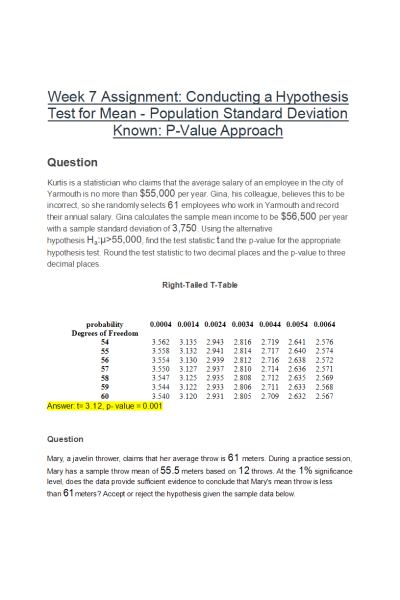MATH 225N Week 7 Assignment; Hypothesis Test for Mean; Population Standard Deviation Known; P-Value Approach
-
$25.00
| Institution | MATH 225N Statistical Reasoning for the Health Sciences |
| Contributor | Patricia |
- Question: Kurtis is a statistician who claims that the average salary of an employee in the city of Yarmouth is no more than $55,000 per year. Gina, his colleague, believes this to be incorrect, so she randomly selects 61 employees who work in Yarmouth and record their annual salary. Gina calculates the sample mean income to be $56,500 per year with a sample standard deviation of 3,750. Using the alternative hypothesis Ha:μ>55,000, find the test statistic tand the p-value for the appropriate hypothesis test. Round the test statistic to two decimal places and the p-value to three decimal places.
- Question: Mary, a javelin thrower, claims that her average throw is 61 meters. During a practice session, Maryhasasamplethrowmeanof55.5metersbasedon12throws.Atthe1%significance level, does the data provide sufficient evidence to conclude that Mary's mean throw isless
than 61meters? Accept or reject the hypothesis given the sample data below.
- Question: Jacqueline, a golfer, has a sample driving distance mean of 202.0 yards from 12 drives. Jacqueline still claims that her average driving distance is 223yards, and the low average can be attributed to chance. At the 2% significance level, does the data provide sufficient evidence to conclude that Jacqueline's mean driving distance is less than 223yards? Given the sample data below, accept or reject the hypothesis.
- Question: What is the p-value of a two-tailed one-mean hypothesis test, with a test statistic
of z0=−1.59? (Do not round your answer; compute your answer using a value from the table below.)
- Question: What is the p-value of a two-tailed one-mean hypothesis test, with a test statistic
of z0=−1.73? (Do not round your answer; compute your answer using a value from the table below.)
- Question: What is the p-value of a two-tailed one-mean hypothesis test, with a test statistic
of z0=0.27? (Do not round your answer; compute your answer using a value from the table below.)
- Question: What is the p-value of a two-tailed one-mean hypothesis test, with a test statistic
of z0=0.27? (Do not round your answer; compute your answer using a value from the table below.)
- Question: Christina, a javelin thrower, has a sample throw mean of 62.3 meters from 29 throws. Christina still claims that her average throw is 57 meters, and the high average can be attributed to chance. At the 2% significance level, does the data provide sufficient evidence to conclude that Christina's mean throw is greater than 57meters? Given the sample data below, accept or reject the hypothesis.
- Question: Elizabeth claims that her average typing speed is greater than 87 words per minute. From recent typing trials, it is observed that Elizabeth has a sample typing speed mean of 98.9 words per minute (based on 18trials).
- Question: Shawn, a competitor in cup stacking, has a sample stacking time mean of 9.2 seconds
from 13 trials. Shawn still claims that her average stacking time is 8.5 seconds, and the high average can be attributed to chance. At the 4% significance level, does the data provide sufficient evidence to conclude that Shawn's mean stacking time is greater than 8.5seconds? Given the sample data below, accept or reject the hypothesis.
- Question: Marty, a typist, claims that his average typing speed is 72 words per minute. During a practice session, Marty has a sample typing speed mean of 84 words per minute based on 12 trials. At the 5% significance level, does the data provide sufficient evidence to conclude that his mean typing speed is greater than 72 words per minute? Accept or reject the hypothesis given the sample data below.
- Question: Kathryn, a golfer, has a sample driving distance mean of 187.3 yards from 13 drives. Kathryn still claims that her average driving distance is 207yards, and the low average can be attributed to chance. At the 1% significance level, does the data provide sufficient evidence to conclude that Kathryn's mean driving distance is less than 207 yards? Given the sample data below, accept or reject the hypothesis.
- Question: Timothy, a bowler, has a sample game score mean of 202.1 from 11 games. Timothy still claims that his average game score is 182, and the high average can be attributed to chance. At the 5% significance level, does the data provide sufficient evidence to conclude that Timothy's mean game score is greater than 182? Given the sample data below, accept or reject the hypothesis.
- Question: Jose, a competitor in cup stacking, has a sample stacking time mean of 7.5 seconds
from 13 trials. Jose still claims that his average stacking time is 8.5 seconds, and the low average can be attributed to chance. At the 2% significance level, does the data provide sufficient evidence to conclude that Jose's mean stacking time is less than 8.5 seconds? Given the sample data below, accept or reject the hypothesis.
- Question: Nancy, a golfer, claims that her average driving distance is 253 yards. During a practice session, Nancy has a sample driving distance mean of 229.6 yards based on 18 drives. At the 2% significance level, does the data provide sufficient evidence to conclude that Nancy's mean driving distance is less than 253 yards? Accept or reject the hypothesis given the sample data below.
| Instituition / Term | |
| Term | Summer 2021 |
| Institution | MATH 225N Statistical Reasoning for the Health Sciences |
| Contributor | Patricia |













































































